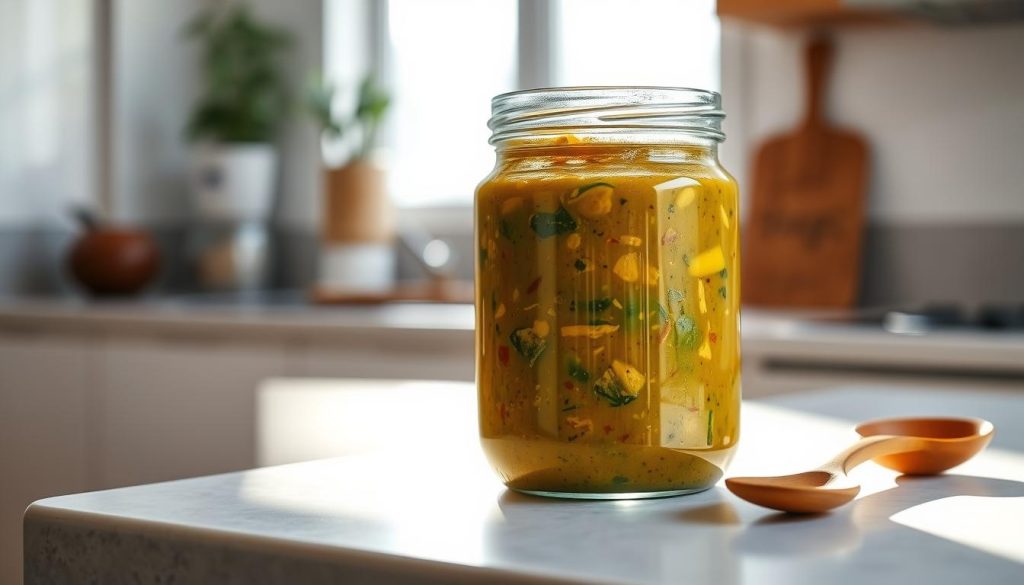Enjoy the Rich Taste of Homemade Egusi Soup

Table of Contents
Homemade Egusi Soup
The first time I tasted egusi soup, it was like discovering a culinary treasure. The rich, creamy texture and bold flavors took me to West Africa’s vibrant kitchens. There, egusi soup is more than a meal; it’s a celebration of culture and tradition.
Egusi soup is a beloved West African delicacy. It has won the hearts of food lovers in Nigeria and beyond. This dish turns ground melon seeds into a delicious culinary experience, showcasing the region’s rich gastronomic heritage.
So, what is egusi soup? It’s a traditional recipe that mixes ground egusi seeds with proteins, vegetables, and spices. It’s a hearty and nutritious meal enjoyed in many African countries, especially in Nigeria. Egusi soup is a testament to the depth and complexity of West African cuisine.
If you’re a culinary adventurer or just looking for new flavors, egusi soup is for you. It offers a unique and exciting dining experience. Get ready to embark on a delicious journey that will change how you see this remarkable dish.
Understanding Nigerian Egusi Soup and Its Cultural Significance

Explore Nigerian cuisine with egusi soup, a dish loved by many. It’s more than just food; it’s a story of culture and tradition. This soup connects us to West African cooking in a special way.
What Are Egusi Seeds?
Egusi seeds are the key to this soup’s magic. They come from melons and are dried, then ground into a fine powder. These seeds are full of nutrients, making them a key ingredient in Nigerian cooking.
- High in protein (approximately 28g per 100g)
- Rich in healthy unsaturated fats
- Contains vital minerals like zinc, magnesium, and calcium
- Excellent source of B-complex vitamins
Traditional Role in African Cuisine
In Nigerian homes, egusi soup is a big deal. It’s served with fufu soup at family gatherings and festivals. Each ethnic group adds its own twist to the recipe.
Health Benefits of Egusi
Eating egusi soup is good for you. The seeds are packed with protein, healthy fats, and minerals. They support your overall health.
- Supports heart health by potentially lowering bad cholesterol
- Boosts immune function through zinc content
- Promotes bone strength with calcium and phosphorus
- May help regulate blood sugar levels
Trying a new egusi soup recipe or exploring West African traditions is rewarding. This dish takes you on a flavorful journey of nutrition and culture.
Essential Ingredients for Perfect Egusi Soup
To make a true egusi soup, you need to pick the best ingredients. These ingredients will bring out the rich flavors of Nigerian food. Your journey starts with knowing the key parts that make egusi soup so loved.
Key Protein Components
The protein in your egusi soup is what makes it rich and deep. Here are some protein choices:
- Fresh cow meat (10-15 pieces)
- Cow skin (5 pieces)
- Smoked catfish (1 full)
- Fresh shrimp (10 pieces)
- Stock fish strips (5-10 pieces)
Fresh Vegetables and Seasonings
For a great egusi soup, fresh ingredients are key. Choose these vegetables:
- Spinach (2-3 cups for garnish)
- Tomatoes (3 whole)
- Red bell peppers (2)
- Scotch bonnet peppers (2)
- Onions (1-2 whole)
Special Spices and Condiments
| Ingredient | Quantity |
|---|---|
| Ground Egusi Seeds | 1 1/2 cups |
| Palm Oil | 1 cup |
| Dry Ground Crayfish | 2 tablespoons |
| Dry Locust Beans | 3 tablespoons |
| Bouillon Cubes | 4 pieces |
Pro tip: The right mix of these ingredients turns a simple dish into a culinary masterpiece. It will take your taste buds to Nigeria.
Step-by-Step Guide to Making Egusi Soup
Making egusi soup is a journey that needs patience and care. This traditional Nigerian dish turns simple ingredients into a rich, flavorful meal. It will surely impress your family and friends.
To begin your egusi soup recipe, gather all your ingredients. Ground melon seeds are essential for this dish. They add a unique nutty flavor and are very nutritious.
- Prepare and chop your chosen proteins (chicken, beef, or fish)
- Grind the egusi seeds into a fine powder
- Heat palm oil in a large pot
- Fry the ground egusi seeds until they turn golden brown
- Add chopped onions and peppers
- Incorporate your protein and stock
- Simmer the mixture on low heat
- Add leafy greens in the final cooking stage
Cooking egusi soup is an art that needs careful timing. Slow simmering allows the flavors to develop and intensify. This creates a soup with remarkable depth and richness. The key is to keep the heat low and steady. This lets each ingredient add its unique character to the dish.
For the best results, use fresh ingredients and take your time with each step. Your patience will be rewarded with a delicious, authentic Nigerian soup. It brings a taste of West African cuisine right to your kitchen.
Selecting and Preparing Your Meats and Fish
Making a great egusi soup starts with picking the right proteins. The key to a tasty fufu soup is in how you prepare the meats and fish. This will make your dish even better.

When getting ready your proteins for egusi soup, focus on a few important choices. These choices add depth and richness to your meal. Here are some top picks:
- Smoked turkey
- Beef
- Chicken
- Goat meat
- Tripe (shaki)
- Dried or fresh fish
Proper Meat Preparation Techniques
Begin by washing your meats well. Use about 1½ pounds (680g) for the best taste. Remove any extra fat and cut into small pieces. Season with garlic and onions to boost the flavors.
Quickly fry the meat in 2 tablespoons of oil. This helps keep it juicy.
Handling and Cleaning Fish
When using fish in your egusi soup, cleaning it right is key. Remove scales, gut the fish, and rinse it well under cold water. Pat it dry with paper towels before cutting it into the right sizes.
Fresh or dried fish can make your fufu soup even more special.
Creating the Perfect Meat Stock
The secret to a top-notch egusi soup is a rich, flavorful meat stock. Boil your chosen meats in enough water to make 3-4 cups of stock. Add chopped tomatoes and a bit of seasoning to make a strong base.
Pro tip: Let your meat simmer until it’s tender, which takes about 30-45 minutes. The stock you get will be the heart of your egusi soup. It promises a meal that’s both healthy and very satisfying.
The Art of Blending Egusi Seeds
Blending egusi seeds is key to making a real egusi soup. It turns these seeds into a creamy base. This base gives the soup its unique taste and texture. How well you grind the seeds affects the soup’s quality.
You can choose from a few ways to prepare egusi seeds:
- Traditional hand grinding using a mortar and pestle
- Modern electric blender for quick processing
- Specialized food processor for consistent results
The secret to a great egusi soup is getting the right texture. You should grind the seeds until they’re very fine and smooth. A bit of graininess can be good, but big chunks can mess up the soup’s smoothness.
To get your egusi ready for cooking:
- Start with 2 cups of egusi seeds
- Grind or blend until it’s a fine powder
- Mix with a bit of water or stock to make a smooth paste
- Let the paste sit for a few minutes to deepen the flavor
Pro tip: Toasting the egusi seeds lightly before grinding can make them taste nuttier. This will make your egusi soup richer. You’re aiming for a smooth, creamy base that makes the soup thick and rich.
Cooking Methods and Timing Guidelines
Getting your egusi soup recipe just right takes focus on cooking methods and timing. The right way to cook can make your dish go from good to amazing. It ensures a tasty meal that goes well with egusi and fufu.
Temperature Control Tips
Keeping the heat in check is key when making egusi soup. Here are some important temperature tips:
- Start with medium-low heat to prevent burning
- Stir consistently to distribute heat evenly
- Allow slow simmering to develop rich flavors
- Reduce heat when adding delicate ingredients
Achieving the Perfect Consistency
The texture of your egusi soup depends on careful cooking techniques. Professional chefs suggest these methods:
- Whisk ground egusi seeds gradually into hot stock
- Control liquid volume for desired thickness
- Simmer uncovered to reduce excess moisture
| Cooking Method | Cooking Time | Heat Level |
|---|---|---|
| Frying Method | 15-20 minutes | Medium |
| Boiling Method | 10-15 minutes | Low-Medium |
Remember, patience is key when making the perfect egusi soup. Keep an eye on your soup, adjust the heat as needed, and trust your cooking skills. This way, you’ll create a truly authentic Nigerian dish.
Serving Suggestions and Traditional Accompaniments
Enjoying egusi soup is even better with the right sides. Fufu is the top choice for this rich, flavorful soup.
Here are some classic sides that make egusi soup even more delicious:
- Fufu: The most traditional accompaniment
- Pounded yam
- White rice
- Eba (cassava flour)
- Amala (yam flour)
Eating egusi soup is a cultural joy. Traditionally, you use your right hand to tear fufu and scoop up the soup. This way, you get to enjoy the egusi’s creamy texture and rich flavors.
If you prefer lighter options, try these:
- Cauliflower rice
- Zucchini noodles
- Oatmeal
How you serve egusi soup matters. Use deep bowls to show off the soup’s color and flavors. Make sure the plate balances, with egusi and fufu as the main attraction.
Tips for Storing and Reheating Your Egusi Soup
Keeping your homemade egusi soup fresh is key. Whether you made a big batch or have leftovers, the right storage and reheating methods are crucial. This way, you can enjoy its rich flavors for days.
Refrigeration Best Practices
Here’s how to store your egusi soup:
- Cool the soup completely before storing
- Use airtight containers to maintain freshness
- Refrigerate within 2 hours of cooking
- Store for up to 4-5 days in the refrigerator
Freezing Your Egusi Soup
Freezing is the best way to keep your egusi soup fresh for a long time:
- Use freezer-safe containers or heavy-duty freezer bags
- Remove excess air to prevent freezer burn
- Freeze for up to 3 months
- Label containers with the date of preparation
Reheating Guidelines
Here’s how to reheat your egusi soup:
| Reheating Method | Instructions | Tips |
|---|---|---|
| Stovetop | Heat on medium-low | Stir occasionally, add water if too thick |
| Microwave | Use medium power, stir every 30 seconds | Cover to retain moisture |
Pro Tip: The soup thickens in the fridge. Always have extra stock or water ready to adjust the consistency when reheating.

Watch for signs of spoilage like bad smell, mold, or unusual color. If unsure, throw it away for safety. By following these tips, you’ll enjoy your homemade egusi soup even more.
Common Mistakes to Avoid When Making Egusi Soup
Making the perfect egusi soup recipe needs focus and knowledge of traditional cooking. Many struggle with getting the right consistency and flavor. Undercooked egusi seeds can make the soup grainy, ruining the smooth feel of your fufu soup.
Watch the cooking time and liquid closely when making egusi soup. Too much water can water down the flavors, while too little can burn the soup. Chefs say to keep an eye on the heat and stir often to avoid burning. You want a thick, creamy soup that goes well with fufu or eba.
Seasoning is key to getting the authentic taste. Novice cooks often under-season or overdo it with spices. Start with a balanced mix of Nigerian spices and taste as you go. Egusi soup can vary in thickness and taste, so adjust your recipe to your liking.
How you prepare vegetables is also important. Overcooking can lose nutrients and flavor, while undercooking makes them tough. Add vegetables towards the end of cooking to keep their color, texture, and nutrients. With practice, you’ll get better at making delicious fufu soup that respects Nigerian cooking traditions.
FAQ
What is egusi soup?
Egusi soup is a traditional West African dish, especially loved in Nigerian cuisine. It’s made with ground egusi (melon) seeds. This thick, nutritious soup is served with fufu and is packed with protein, vegetables, and rich flavors.
What are egusi seeds?
Egusi seeds come from a melon grown in West Africa. They’re ground and used in the soup, giving it a nutty flavor and creamy texture. These seeds are full of protein, healthy fats, and minerals.
What proteins can I use in egusi soup?
You can use many proteins in egusi soup, like beef, goat meat, fish, chicken, and seafood. Each adds its own flavor and nutrition, making the soup versatile.
How do I prepare egusi seeds for the soup?
First, grind the egusi seeds into a fine powder. You can use a blender or traditional grinding. Then, fry them lightly to bring out their nutty flavor. Mix them with water or stock to make a smooth paste.
What is fufu, and how is it served with egusi soup?
Fufu is a soft, dough-like staple made from boiled and pounded starchy vegetables like cassava or yams. It’s served with egusi soup. Diners use fufu to scoop up the soup.
How long can I store egusi soup?
Store egusi soup in an airtight container in the fridge for 3-4 days. You can freeze it for up to 2-3 months. Always cool it down before storing and reheat well before eating.
Is egusi soup healthy?
Yes, egusi soup is very healthy. The egusi seeds are full of protein, healthy fats, vitamins, and minerals. Adding vegetables and lean proteins makes it a nutritious meal with many health benefits.
Can I make egusi soup vegetarian?
Absolutely! You can make a vegetarian version by leaving out the meat. Use plant-based proteins like tofu or more vegetables. The egusi seeds are the main ingredient, providing protein and flavor.
What makes egusi soup unique?
Egusi soup is unique because of its use of ground melon seeds. This creates a thick, creamy texture. The mix of traditional spices, local proteins, and fresh vegetables gives it a rich flavor that’s different from other soups.
